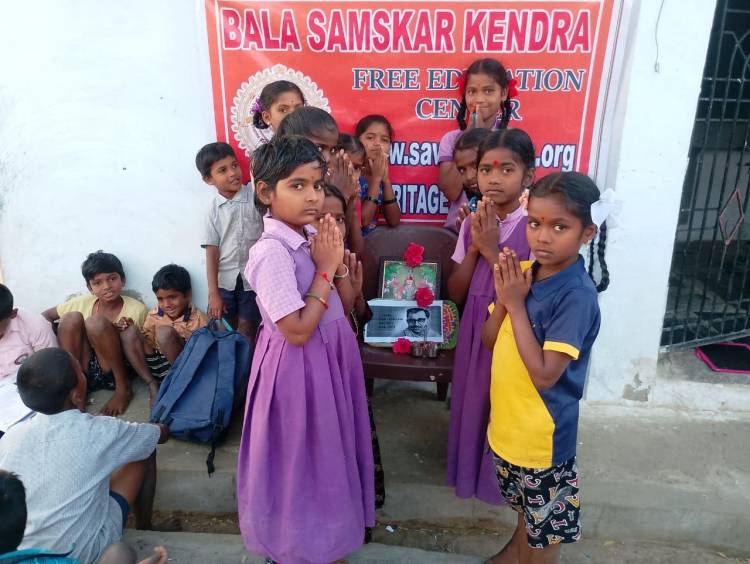[GHHF] Bala Samskar Students learned about Pandit Deendayal Upadhyaya and his tireless work to promote the mission of RSS.
 Global Hindu Heritage Foundation started Bala Samskar Kendras to teach about the depth our culture and inspire them by teaching about the great sacrifices our national heroes made to protect Sanatana Dharma.
Global Hindu Heritage Foundation started Bala Samskar Kendras to teach about the depth our culture and inspire them by teaching about the great sacrifices our national heroes made to protect Sanatana Dharma.
Some individuals live until their demise, while others leave a lasting impact that endures beyond their passing. The second category includes Pandita Deendayal Upadhyay.
Born on September 25, 1916, in a very ordinary family, he grew up as an extraordinary person. Deendayal Ji grew up in his maternal uncle's house after his mother and father died when he was young. Dayal, who started his primary education in 1925, got acquainted with the RSS while studying for his BA in Kanpur. Since then, his life path and destination have changed. While working in the Sangh, he completed his BA, degree, and first year of teacher training MA.
He quit his studies to devote full time to the expansion of the Sangh. He was appointed as a Pracharak for the Labhampur area of Uttar Pradesh and within a few years, he developed the Sangh's programs in that area. Noticing this, the Sangh elders appointed him as the co-Pracharak for the Uttar Pradesh region. His extraordinary talent impressed everyone.
While watching the Sangh's activities, he focused on the field of journalism and established an organization called Rashtra Dharma Prakashan. Through that Prakashan, a monthly magazine called Rashtra Dharma, a weekly magazine called Panchajanya, and a daily magazine called Swadesh were started. Those magazines became symbols of Deendayal’s work!
The then Prime Minister Nehru banned the Sangh, blaming the Hindu Mahasabha as well as the RSS for the murder of Gandhiji. Deenadayalji’s role in the movement to remove that ban was significant in Uttar Pradesh. Deendayal ji made it clear in Panchajanya that the Sangh had no role in this murder, and the government of the time banned Panchajanya for its writings against the government's repressive policies. Instead, he started another weekly magazine called Himalaya and created confusion in the government of the time with his pen. In the meantime, the Supreme Court of India ruled that the RSS had no role in the assassination of Gandhiji.
His writings continued his views and basic principles on issues such as race, nationality, Indian culture, religion, etc. Dayalji also authored historical novels such as Samrat, Chandragupta, and Jagadguru Shankaracharya, applying the social, economic, and political policies of that time and the essence of Indian philosophy according to the conditions of the country.
In 1951, Dr. Shyam Prasad Mukherjee resigned from the post of Union Minister in protest the policies of Prime Minister Nehruji and came out. In order to counter the Muslim appeasement and anti-Hindu policies pursued by the Congress Party, which was in power across the country at that time, he sought the help of the then RSS Sar Sangh Chalak Param Pujyaniya Guruji with the intention of establishing a political party with members of Indian culture and national sentiments. As per his wish, some other young people like Pandit Deendayal Upadhyay, Atal Ji, Jagannath Rao Ji, Sundar Singh Bhandari were handed over.
Dr. Shyam Prasad Mukherjee was elected as the General Secretary of the Jana Sangh Party formed on 21 October 1951. Just three months after the party was formed, the Jana Sangh was recognized by the Election Commission as one of the four national political parties that contested the general elections held in 1952. It was able to prove its existence in the general elections. This was due to the leadership of Dr. Shyam Prasad Mukherjee as well as the coordination skills of Deendayal Ji.
After that, Dr. Mukherjee, who was conducting Satyagraha in Kashmir, died under suspicious circumstances. After the death of Dr. Shyam Prasad Mukherjee, the credit goes to Deenadayalji and his colleagues for strengthening the party across the country, overturning the ideas of those who hoped that the Jana Sangh would disappear in name and form. To silence those who said that the Bharatiya Jana Sangh had no principles, he proposed the theory of Ekatmata Manatava Vadam.
In it, he argued that the right way of life for a man who is at the bottom is to flourish with worldly happiness and serve humanity with a spiritual vision. Deenadayalji, who served as the All-India Secretary of the Bharatiya Jana Sangh for a long time, shaped the hearts and minds of the workers and won a very prominent place in their minds.
Not knowing what happiness is, he experienced hardships and became engaged in serving the country and adopted it as his life's work. Since joining the Jana Sangh, he led the party as a great leader and contributed to giving the Jana Sangh a special place in the country's politics, becoming the All India President of the party in 1967. He gained great fame by demonstrating the vision of India at the All-India Jana Sangh Mahasabha held in Calicut. That fame caused the enemies of the Jana Sangh ideology to be angry. The great ascetic fell victim to their evil politics. He was found dead on the railway tracks at Mughal Sarai railway station in Uttar Pradesh on February 11, 1968. Like the death of Dr. Shyam Prasad Mukherjee, the death of Deenadayalji also led to many suspicions. The hearts of the workers were deeply saddened by the death of a great person like Deenadayalji....
Your donations are appreciated.
By Zelle: ghhfusaorg@gmail.com
PayPal: savetemples.org
By Check: Or you can send a check payable to GHHF, 14726 Harmony Lane, Frisco, TX 75035.
It is tax-deductible.
By Rupees: call 601-918-7111; +91 83096 43979























 Urgent support needed for Bangladesh Hindus
Urgent support needed for Bangladesh Hindus 







